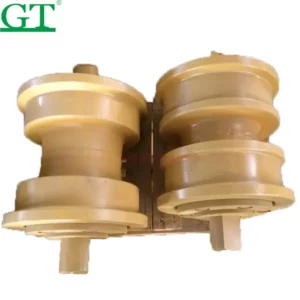Adjusting the tension in a track using upper track rollers is not a common method in modern excavators or heavy equipment. The tension in the track of an excavator is typically adjusted using a dedicated track adjuster assembly, which is located near the front or rear of the undercarriage.
However, the upper track rollers play a crucial role in supporting the weight of the excavator and maintaining proper track alignment. While they do not directly adjust track tension, they can indirectly affect it by influencing the distribution of weight and tension along the track.
Here are the general steps to adjust track tension using a track adjuster assembly, which does not involve upper track rollers:
- Locate the Track Adjuster Assembly: The track adjuster assembly is typically located near the front or rear of the undercarriage, depending on the excavator model. It consists of a hydraulic or mechanical mechanism that applies tension to the track.
- Release Track Tension: Before adjusting the tension, release the existing tension in the track by loosening the tension adjustment mechanism. This may involve releasing hydraulic pressure or loosening locking nuts or bolts.
- Adjust Track Tension: Use the adjustment mechanism on the track adjuster assembly to increase or decrease track tension as needed. This may involve turning a tensioning screw or bolt to extend or retract the piston rod, thereby applying or releasing tension on the track.
- Check Tension: Once the desired tension is applied, check the tension of the track by pressing down on the track between two track rollers. upper track rollers for sale The track should have a slight amount of deflection but should not be overly loose or tight.
- Secure Adjustment: Once the correct tension is achieved, secure the adjustment mechanism to prevent it from loosening or changing position during operation. This may involve tightening locking nuts or bolts to secure the adjustment mechanism in place.
- Test Operation: After adjusting track tension, test the operation of the excavator to ensure that the tracks move smoothly and that there are no abnormal vibrations or noises. Adjustments may need to be fine-tuned based on the performance of the excavator in various operating conditions.
It’s important to consult the manufacturer’s guidelines and specifications for the specific excavator model being serviced, as the adjustment procedure may vary depending on the design and configuration of the track adjuster assembly. Additionally, proper maintenance and periodic inspection of the undercarriage components, including the upper track rollers, are essential for ensuring optimal performance and longevity of the excavator tracks.
